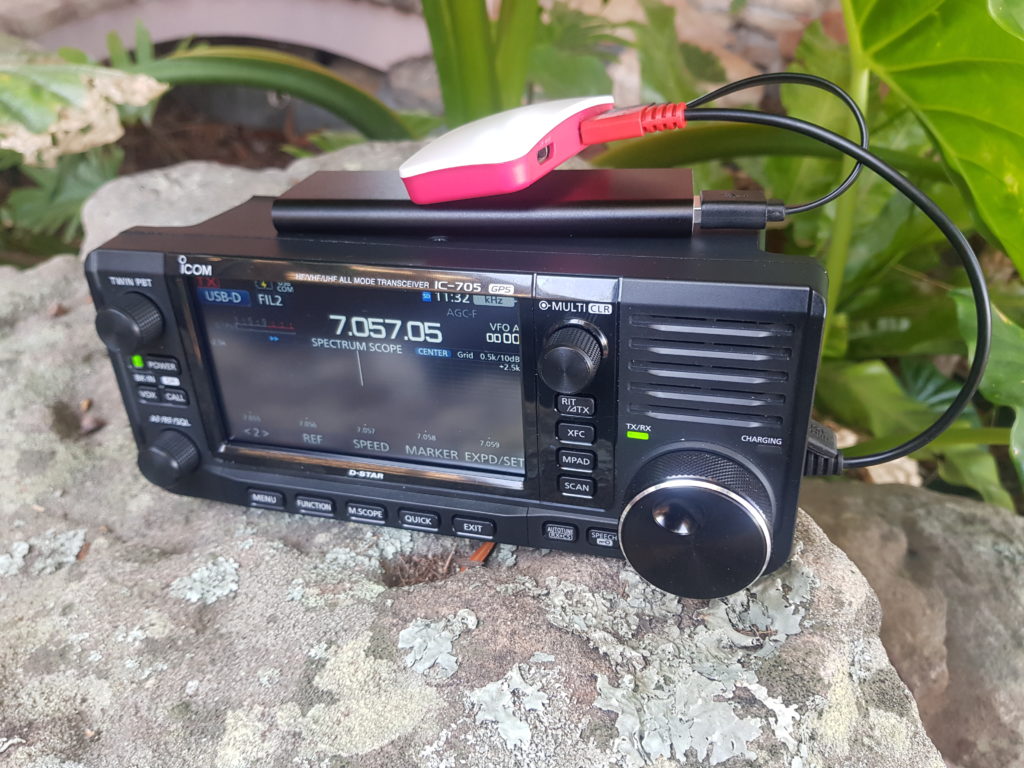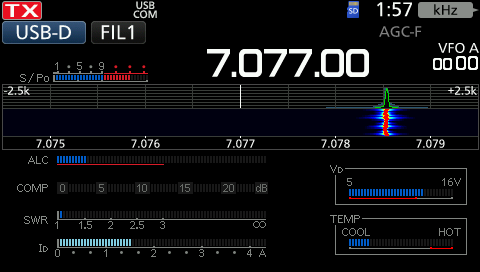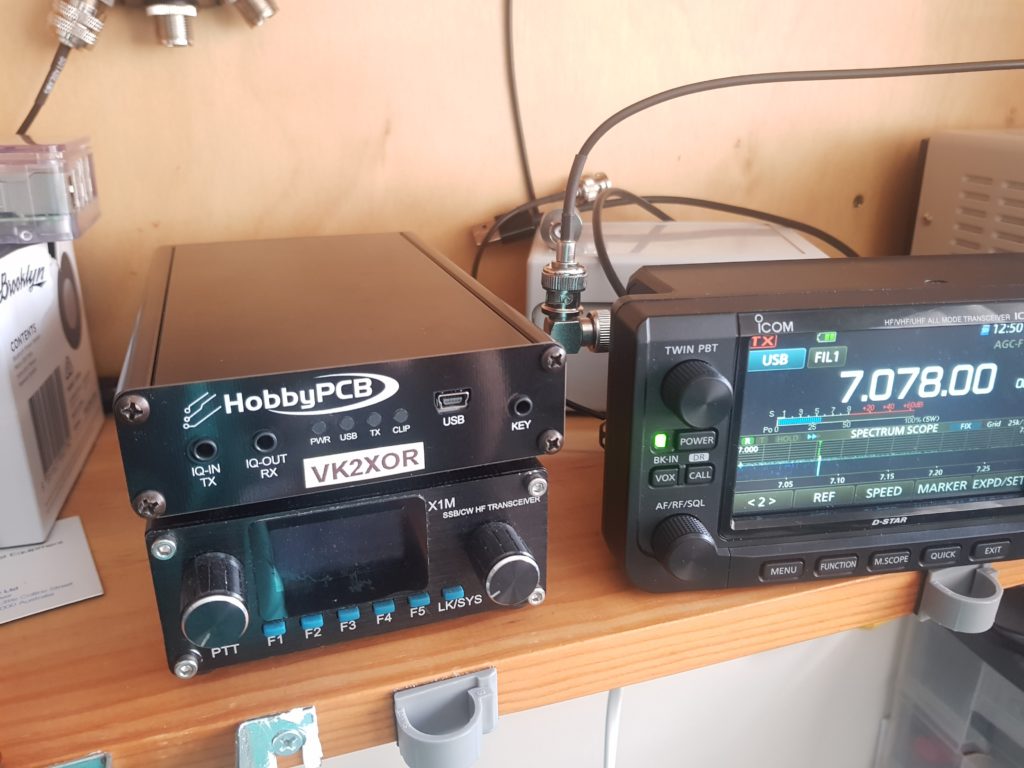Not. one. bit.
This is a follow-up post to the article I wrote about my decision to pre-order an IC-705. If you haven’t read it, I suggest you do so first to get where I’m coming from, then come back here to read on.

What can I say? The IC-705 has met, and probably exceeded my expectations. I almost titled this post “Would I buy another IC-705? No!” with an introductory line of “…because this radio offers so much, you only need one!”. However, I thought it a bit too click-baity. Keep in mind that this is my first Icom radio – I’m not an existing user of the IC-7300 or similar, so some of my thoughts on this rig may seem obvious to owners of such Icom rigs. However, I believe they are relevant points regardless, when considering this radio amongst its peers.
Let’s revisit some key points for my decision to buy this radio in the first place. Recall that I’ve been wanting to upgrade from my Xiegu X1M Pro for a number of years now. I wanted a portable, all-mode “shack in a box”. The IC-705 is, without a doubt, about as much of a portable shack in a box as you could get. I wanted something with a modern built-in battery; tick. I wanted something I could interface with a laptop or Raspberry Pi for digital modes like JS8Call; huge box-tick there with the single cable interface. (Having CAT control and audio all on one USB cable allows one to send email with this rig with a humble Raspberry Pi Zero; more on that in a future post.) I was also wanting a second D-Star radio to try out more data aspects of that mode (D-Rats, texting, sending photos, etc), so the 705 fit that gap in my kit as well. I’ve already done some fun trials with the 705 and my D74, and more lie ahead.
“The IC-705 has performed excellently and been an absolute pleasure to operate.”
It is also the first rig I’ve owned capable of doing SSB and CW on VHF/UHF. The Multi-meter screen has lived up to and exceeded my expectations. When running digital modes with computer, being able to see the waveform, input drive level, SWR, temperature, and power output all at once is absolutely awesome. Also, having the compression level indication there has saved me a couple of times when I forgot to turn compression off after using voice. The IC-705 has performed excellently and been an absolute pleasure to operate.

So, the IC-705 has met my needs and expectations for what I was looking for. Let’s talk now about a few aspects of this radio that weren’t selling points for me, but that have proven hugely useful. Firstly, the panadapter screen. When I bought the rig, I couldn’t have cared less if a portable radio had this, whether built-in or as an option. I certainly would never want to lug along a PX3 in addition to other gear on a hike. But boy oh boy has this thing been useful in more ways than I’d thought. Those of you who’ve used a panadapter before are no-doubt scoffing at my ignorance right now, and know how useful this feature can be for hunting for signals – or an open spot – on the band. A real plus for contesting, though I’m not much of a contestor. But aside from the traditional uses, which I’ve unexpectedly found useful, a real help was when I was able to use the waterfall and S-meter to verify and hunt down a couple of RFI-producing devices in my house. My noise floor was previously S7-S9 and is now usually below S3. I’ll share more detail on that in a later post. Another feature that should have been an obvious pull for me: the IF filtering. I knew this would be better than the lack of filtering on my X1M, but it wasn’t a deciding factor for me, as most of the other options I was considering also have filtering. That said, the filtering really works. Even without a mechanical filter, the 705 is capable of really popping signals out from the noise with its filtering.
“They were about -20db below the noise. I put a tight filter around their signal and they popped up to +10db above the noise and I was now getting full copy.”
One example I was very happy with was when I was working a weak JS8Call contact one day. They were way down near the FT8/JS8 limit of about -20db below the noise. I put a tight filter around their signal and they popped up to +10db above the noise and I was now getting full copy for the rest of the QSO instead of several missed frames. Tight CW filtering sounds beautiful as well, and shifting the offset of an SSB filter very nicely cuts out static or nearby stations. This is not new, but was new to me, and I’ve enjoyed using it. Another feature is SWR plotter – this is an awesome feature, and something I haven’t had before. It’s really helped me when adjusting the whip length on the PAC-12 and making adjustments on an off-centre-fed dipole. The fourth and final (for this list) feature that wasn’t a selling point for me, but that I’m happy it has is the built-in GPS. Not a lot to write here, but whenever you’re out portable, it’s nice to have a GPS time source and know your coordinates – the 705 can send both via USB cable, by the way. Off-grid and want to run modes like FT8? You can get CAT control, audio in/out, position, and accurate time all through the single USB cable. How awesome is that?? (I recommend leaving GPS turned off as much as possible, as it’s the #1 battery eater on rigs and other devices. Come to think of it, I should write an article on how I use GPS on my rigs…) Honourable mention goes to Bluetooth, which has been handy both for seeing and controlling the status of the rig, as well as listening to HF nets whilst cleaning up the kitchen.
So, as much as I’ve enjoyed this radio, I know that you’ll also want to know about some of the not-so-positive aspects. I really had to think for this, as they’re pretty negligible and in no-way deal-breakers. These are not things that I’ve ever caught myself repeatedly annoyed or frustrated with. In no particular order: D-Star terminal mode is not as capable or well-documented as I’d hoped; I wish you could send screenshots via D-Star; The rig felt a little heavier than I’d expected when I first pulled it out of the box; the rig has built-in RTTY, but not PSK. As I said, none of these are deal-breakers. Terminal mode and RTTY/PSK weren’t things I was really hoping to use, and the weight hasn’t yet stopped me from taking it anywhere I was planning to. It’s already come with me on a hike to a nearby summit, and several shorter walks as well. I’d perhaps consider something that took up less weight and space if I go on a longer backpacking trip; we’ll see – I plan to give it a go on at least one longer hike this summer!
It may surprise some of you, but lack of internal tuner is not on the list for me – keep in mind that I mainly use resonant antennas, antennas with their own mechanical tuner at the feed-point, and I already had an Elecraft T1, which I’ve used a couple of times with the 705. Also not a list is the relatively small-capacity battery. This one is even a surprise to me. Icom rated the IC-705 as getting about three hours of typical usage on the supplied BP-272, and the first accessory on my list is the larger BP-307, once that comes out. Now I haven’t yet taken this radio out as many times, or for as long of trips as I’d like, but so far, I’ve never run out of juice. This includes a summit hike where we operated all afternoon before heading down. I’ll still get a BP-307 because I want more than one battery, and because I don’t think I’ve given the rig enough of a workout on the BP-272. I do have various power options I’ve used with this rig so far (did you know it can charge via USB?!) and plan to do more trials with power options in the future.
How about the price? I mentioned in the opening that I compare this radio amongst its peers. It’s important to note that its peers are not the IC-7300, 9700, etc. Those are fantastic base station and perhaps vehicle-portable rigs. The IC-705, on the other hand, is a much more portable radio with a lot more built into one little package. So, when considering the IC-705, its price, and its features, one needs to look at it next to tranceivers like the Elecraft KX line, the Yaesu 817/8, Xiegu G90 and X5105, and the Lab 599 Discovery TX-500. I’ll let you have a look at that spread, and their features and prices, and let you decide whether the IC-705 is priced right. I love operating portable more than from home, and I would have bought an IC-7300 a few years ago if I could take it along on a hike. Now, the 7300 has a more portable sibling with loads of extra features.
In closing (for now): I love having gear that is as capable as the IC-705; it’s really turned out to the Swiss-Army knife all-mode/band transceiver I had hoped it would be. For me, this radio has been a fantastic purchase so far, and I’ve no doubt it will bring me joy in several areas of the hobby for years to come.
Still reading? Want to know what’s next? Upcoming content is going to be focused on using gear. Or rather, making the most of gear / using it to its full extent. I’ve got some tips I want to share with you, regarding the IC-705, and other things as well. There will hopefully be some video content coming as well. I hope you’ll join me for the journey!
Thanks and 73,
Max VK2XOR

